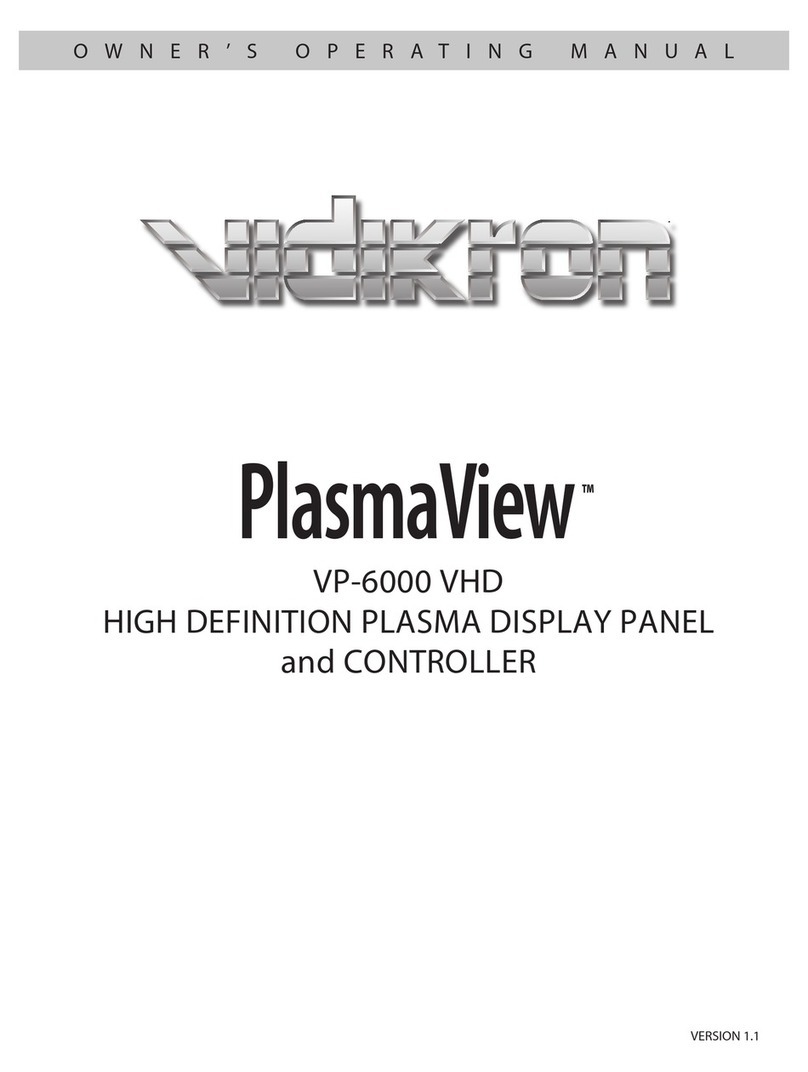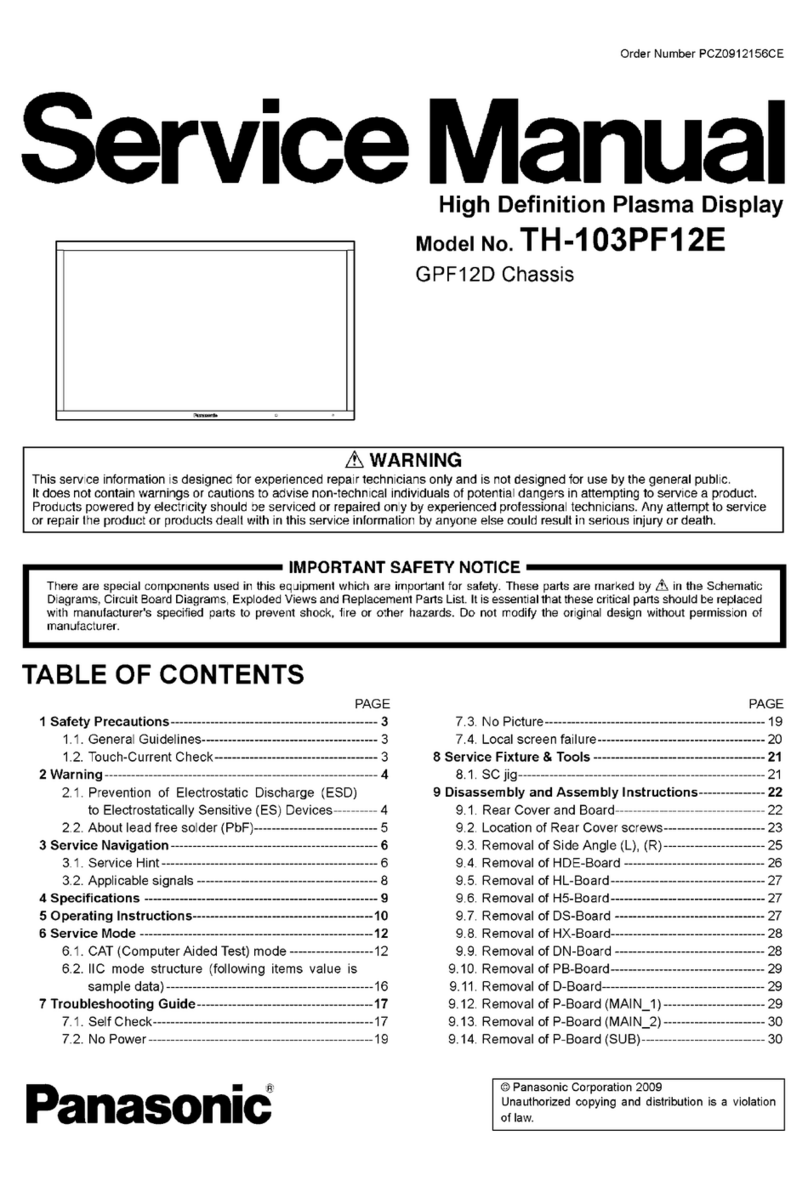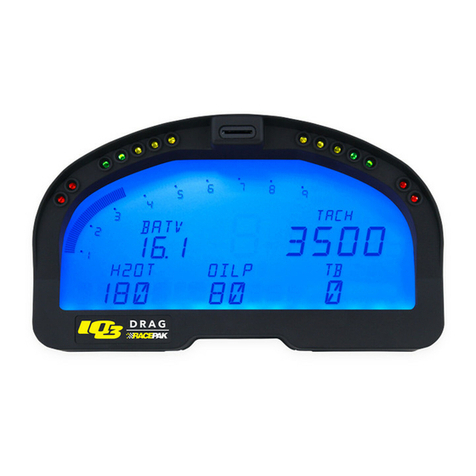Gordon DM3000 Manual

OPERATION&MAINTENANCEMANUAL
BRAKEMONITOR
MODELDM3000
Goro
dn
Engineering Corp.
67DelMarDrive
Brookfield,CT06804
tollfree
fax
1.800.315.9233
1.203.775.1162
12/01
www.gordoneng.com
www.stampersstore.com

WARRANTY
Seller warrants equipment manufactured by it against defects in material and workmanship for a
period of five years from date of sale. Seller's sole responsibility under this warranty is limited to
the repair or replacement without charge of any part of the Seller's equipment which is proven to
have failed when used in strict accordance with the Seller's installation and operating
instructions. Such repair or replacement is Purchaser's exclusive rememdy and Purchaser, at
Purchaser's expense, must return all such parts to Seller's plant, unless such parts are destroyed or
not within Purchaser's control. Repaired parts or replacements will be shipped to Purchaser
F.O.B. Seller's plant. Modifications, incorrect installations or improper operation of equipment
by purchaser voids this warranty. This warranty is in lieu of all other warranties, express or
implied, including any warranty of merchantability and fitness for a particular purpose, and
Seller shall have no responsibility for consequential losses or damages resulting from defects in
such equipment.
i

FAIL-SAFE OPERATION
IMPORTANT: NOTE THE FOLLOWING.
1. This equipment is designed to meet the OSHA requirements for being fail-safe,
which are stated in Section 1910.217(b)(8)(vi) as follows:
"Electrical clutch/brake control circuits shall incorporate features to minimize the
possibility of unintended stroke in the event of the failure of a control component
to function properly, including relays, limits switches, and static output circuits."
The Model DM3000 BRAKE MONITOR design includes a self-checking circuit,
which operates continuously and independently of machine cycle, and detects
certain functional failures. Any failure detected by the self-check will cause the
control relay to de-energize and the SELF CHECK light to go on. The cause of the
malfunction must be determined before operation can continue.
2. Before installing the BRAKE MONITOR system, READ THE MANUAL.
Particularly note: Chapter 2 system information.
Chapter 3 for installation.
Chapter 4 for operation.
The system should be checked daily, in accordance with the operational test in
Chapter 4, or after any changes involving dies, personnel, or environment.
3. If constant readjustment is required, without changing conditions, something is
wrong with the system, environment, or installation, and must be corrected.
4. Obviously, fail-safe design is a matter of degree, i.e., reducing the probability of
unsafe failure to minimum practical level. The foregoing instructions are directed
at further reducing this probability level. The user must pay strict attention to all
factors regarding safety on a hazardous machine. This includes operator methods
and attitudes, use of complementary guarding, use of reliable fail-safe type
controls, and attention to situations peculiar to his particular operation.
5. A chain break detection circuit is provided to the monitor the output of a cam chain
driven Motion Detector. If, for any reason, (broken chain, etc.) the motion signal is
not present at the Brake Monitor after initiation of a stroke, the STOP ALARM relay
contact will open and prevent further cycling of the machine.
6. Additional assurance of safe operation may be realized by a periodic inspection of
the BRAKE MONITOR to see that stopping times are being indicated on the
display in a normal manner. Set the stop time below the normal stopping time of
the press and see that it prevents a subsequent cycle before resetting.
ii

TABLE OF CONTENTS
WARRANTY ............................................................................. i
FAIL-SAFE OPERATION ....................................................... ii
HOW TO USE THIS MANUAL ............................................ 1
Chapter 1: GENERAL DESCRIPTION
Summary .................................................................................... 3
DM3000 Enhanced Features .................................................... 4
DM3000 Specifications ..............................................................5
Chapter 2: THEORY OF OPERATION
Overview .................................................................................... 9
Chapter 3: INSTALLATION
Motion Detector ......................................................................... 11
Control .........................................................................................13
Chapter 4: OPERATING INSTRUCTIONS
Operational Warnings ...............................................................17
Power-up Sequence ...................................................................17
Auto-Learn Operation ...............................................................19
Manual Setup ........................................................................20
Point of Operation Guards & Two Hand Trip Controls…... 22
System Reaction Times ..................................................22
Safety Distance Formula ............................................... 22
Stopping Time Too Long .............................................. 23
Variable Speed Machines ..........................................................23
Operational Test .........................................................................24
Chapter 5: TROUBLESHOOTING
Checklist ................................................................................ 27
Failcodes ................................................................................28
Electrical Noise .....................................................................29
Appendix A: Simple Check-out Procedure ............................33
Appendix B: Options .................................................................34
Appendix C: Safety Distance Table .........................................35
iii

(This page intentionally left blank)
iv

HOW TO USE THIS MANUAL
NOTE: READ AND UNDERSTAND WARRANTY AND FAIL-SAFE OPERATION.
Starting with page 3
FOLLOW:
Chapter 1: General Description
Appendix A: Simple Check
Chapter 2: Theory of Operation
Chapter 3: Installation
Chapter 4: Operating Instructions
Starting with page 4
FOLLOW: DM3000 enhanced features
Chapter 3: Installation
Chapter 4: Operating Instructions
Starting with page 17
FOLLOW:
Chapter 4: Operating Instructions
Starting with page 27
FOLLOW:
Chapter 5: Troubleshooting
1
NEW DM3000
USER
DM325 EXPERIENCED
USER
DM3000 EXPERIENCED
USER
TROUBLESHOOTING
GUIDE

(This page intentionally left blank)
2

Chapter 1
General Description
The DM3000 BRAKE MONITOR is composed of a control unit, a motion detector, and a
10' interconnecting cable. The control unit houses the 3 digit LED display (which
indicates press stopping time), warning LEDS, and a keypad (which allows setting of
alarm levels). The control unit has electrical connections for the machine's brake
solenoid line (input), the warning and stop alarm relays, and the motion detector. The
motion detector is mechanically connected to a rotating part (usually the cam box shaft
drive chain) of the press. It supplies an electrical signal to the DM3000 corresponding to
press ram motion. (See Figure 1).
Over a period of time, the clutch or brake of any press will start to wear. As this
happens, the stopping time of a press will become increasingly greater. Thus the press
could continue to operate when it is supposed to stop, and possibly cause injury to the
operator.
The DM3000 BRAKE MONITOR is a microprocessor based safety device designed to
monitor the stopping time of any press having a brake/clutch system. On every stop of
the press, the DM3000 measures the stopping time and compares it to a previously set
level. If the stop time nears the pre-set warning alarm time, the press is allowed to
continue operating, but a warning alarm occurs, indicating the brake should be serviced
before it reaches a dangerous level. If the stop time exceeds a higher pre-set stop alarm
time, a stop alarm occurs and the press is stopped, with further operation possible only
after resetting by authorized personnel.
3
Figure 1
Motion
Detector
Control Unit

1.2
DM3000 Enhanced Features
In comparison to earlier models, the DM3000 BRAKE MONITOR has the following
features:
Microprocessor based electronics for better reliability and improved noise
immunity.
The 3 digit LED display, visible from the front panel, displays either stopping time
or reserve time (time left before an alarm) on each press stop.
An additional self-contained safety relay has relay contacts which are connected in
series with the control relay contacts. These relays are designed for safety
applications and use a unique relay armature configuration that allows detection of
a welded control contact. If a welded contact is detected, the redundant safety relay
is opened to interrupt machine operation. If a fault is detected by the self check
circuit, both control and safety relays will automatically de-energize.
Measured stopping range is now from 10 millisecs. to 9.99 seconds.
The Chain Break Delay Time can be set from 100 millisecs. to 9.99 secs.
An auto-learn mode automatically adjusts settings for a particular press.
Self checking is continuous, independent of press cycle.
A keypad allows entering and changing of stop alarm, warning alarm, and chain
break delay times. (An access code allows only an authorized user to change
settings.) In the advent of an alarm, reset of the DM3000 is also via an access code
entered by the keypad.
Improved filtering on the brake solenoid and motion input lines ensures better
noise immunity and less likelihood of false alarms.
When a new die is being set up and a machine is run in motor-off inch or bar mode,
the DM3000 can be put into motor-off inch mode, so that during the setup period,
loss of motion will not cause an alarm.
Unit displays failure codes on display for easier troubleshooting.
4

1.3
DM3000 Specifications
Voltage Input: 115 VAC, 50/60 hertz, +/-15%, single phase
Current Input: 50 mA. (AC -RMS)
Power Consumption: 6 VA
Control Relay Load Rating: 115 VAC: 2.5 A, (resistive), .25 A, (inductive)
Warning Relay Load Rating: 115/230 VAC: 8 A
Relay Contact Arrangement: Normally closed contact
System Reaction Time:Normal alarm: 12 mSECs, max.
Safety alarm -additional 17 mSECs, max.
Self Checking: Continuous, every 5 mSECs, independent of press
cycle
Enclosure: NEMA 12 (Industrial Plastic box) (see Fig. 3)
w/ mounting flange, 10.2" L x 6.1" W x 4.0" D
(259mm L x 154mm W x 102 mm D)
Mounting: To any bulkhead, chassis, or control panel -vertical
or horizontal. (see Fig. 4)
Environment: Unaffected by normally encountered conditions (i.e.,
dirt, grease, humidity, vibration, etc.).
Weight: 4 lbs. (1.8 kg)
5

Indicators and Controls:
Alarm LED -Indicates an alarm condition. Stop relay is opened (de-energized).
DM3000 must be reset.
Chain Break LED -Indicates broken chain or other motion failure.
Warning LED -Indicates that stopping time has exceeded the pre-set warning
level.
Self Check LED -When on continuously, indicates an internal failure within the
DM3000 has occurred. Normally the LED will blink on briefly
during each press cycle to indicate the beginning of stop time
measurement.
Stop Time LED -Indicates that the stopping time is being shown on the display.
Reserve LED -Indicates that the reserve time (time remaining before a stop
alarm will occur) is being shown on the 3 digit LED display.
3 digit LED display-Shows either the stopping time or reserve time.
6
Alarm LED
Keypad
Display

Keypad -Three keys: KEY 1 (increment), KEY 2 (decrement), key 3 (set). During
normal operation, pressing key 1 will display stop time and pressing key
2 will display reserve time. The keys are also used for entering the chain
break delay, stop, and warning alarm times. Settings can only be
changed by authorized personnel.
Keylock On units equipped with a Keylock, a key is used to reset the unit from an
alarm condition, or to put the unit into setup mode. The Keylock is
located on the right side of the unit. Only authorized personnel should be
in possesion of the key. Once the unit is reset or taken out of setup, and
put back into Run mode, the key should be removed from the lock and
held by authorized personnel.
Reset: Keylock To reset a Keylock unit, insert the key, and turn the key to the
Reset/Setup position. Note that the Stop Time and Reserve LEDs are
alternately blinking. Turn the key back to the Run position. The unit
will now reset and be able to run normally. Remove the key from the
lock. Note: only authorized personnel should perform this operation.
Setup: Keylock To put the unit into setup, follow the instructions on page 19 for
Autolearn Setup, page 20 for Manual Setup, or page 23 for Motor Off
Inch Mode/Troubleshoot Mode.
Reset: No Keylock If unit is not equipped with a Keylock, reset the unit by entering the
following key sequence: 3 -1 -3 -2 -2.
Setup: No Keylock To put the unit into setup, follow the instructions on page 19 for
Autolearn Setup, page 20 for Manual Setup, or page 23 for Motor Off
Inch Mode/Troubleshoot Mode.
7

(This page intentionally left blank)
8

Chapter 2
Theory of Operation
A press's brake solenoid is a voltage activated switch that controls the brake/clutch
system. When voltage is removed from the brake solenoid, the clutch is released, the
brake applied, and the press begins slowing to a stop. At that instant, the DM3000 starts
counting stopping time.
The motion detector, which is mechanically connected to a rotating part (usually the
cam box shaft drive chain) of the press, supplies a voltage to the DM3000 for as long as
the ram is in motion. When the ram stops, this voltage goes to zero and the DM3000
counter stops. The measured stop time is then displayed on the DM3000 3 digit LED
display.
WARNING ALARM
If the stopping time of the press is greater than the pre-set warning alarm setting, the
press is allowed to continue running, but a warning alarm is issued. The warning LED
lights, and the warning relay is closed (energized). The warning relay can be made to
activate a light, alarm, or other function. This indicates that the brake on the machine is
starting to wear and that maintenance should be scheduled. At the start of the next
press cycle, the warning alarm resets automatically.
STOP ALARM
If the stopping time of the press is greater than the pre-set stop alarm setting, the alarm
LED lights and the stop alarm relay is opened (de-energized), stopping the press. This
indicates that the brake has worn past a safe level, and that maintenance must be
performed immediately. The DM3000 stop alarm relay remains open, preventing the
press from operating further, and can only be reset by a setup person with the DM3000
access code.
CHAIN BREAK
In addition to measuring stopping time, the DM3000 monitors for a broken chain
condition. The motion detector is mechanically connected to some rotating part on the
press (usually connected to the cam box shaft), via a chain or belt. If this chain were to
break, an unsafe condition would exist in that the DM3000 would never see a motion
signal, and thus never count stopping time. If the press brake is released, and no motion
occurs, the DM3000 issues a chain break alarm. The chain break LED lights, the alarm
LED lights, and the stop relay is opened, causing the press to stop. The chain must be
checked and repaired before resuming press operation (see Troubleshooting, Chapter
6).
9

CHAIN BREAK DELAY TIME
After the brake is released on a press, there will be a certain amount of delay before
motion starts, due to clutch slippage. To allow for this (and so that a premature chain
break alarm does not occur), the DM3000 has a selectable chain break delay time
feature.
When the brake is released (voltage applied to brake solenoid), the DM3000 starts
counting chain break delay time. The occurrence of motion ends the chain break
counting period. If motion does not start before the end of the chain break delay time,
the DM3000 issues a chain break alarm, lighting the chain break and alarm LEDS, and
opening the stop relay. Note that a chain break alarm can be caused by either a broken
chain or a clutch that has worn excessively.
The chain break delay time is adjusted by the user. See Chapter 4, Operating
Instructions, for further details on adjustment.
10

Chapter 3
Installation
NOTE: READ AND UNDERSTAND WARRANTY AND FAIL-SAFE OPERATION.
MOTION DETECTOR
The Motion Detector is a rotary device which provides an output as long as its shaft is rotating. It
is usually mechanically coupled to the cam box shaft drive chain of the press, although it may be
connected to any part that rotates while the ram is in motion, and stops when the ram stops.
NOTE: IF THE PRESS HAS A CAM BOX OR ROTARY LIMIT SWITCH, IT IS
IMPERATIVE THAT THE MOTION DETECTOR BE INSTALLED SO THAT IT CAN
MONITOR THE CAM DRIVE. CAM OR LIMIT SWITCH DRIVE FAILURE CAN
RESULT IN THE ELECTRICAL PRESS CONTROL NOT BEING AWARE OF WHAT THE
MECHANICAL PORTION OF THE PRESS IS DOING. THIS CAN RESULT IN SERIOUS
INJURY TO THE OPERATOR.
11

1. Shaft size: The motion detector shaft is 5/8" diameter (15.88mm) with a 3/16"
(4.76mm) keyway.
2. Speed Requirements: The motion detector will operate at any rotary speed of 6
RPM (1 revolution in 10 seconds) or higher. For lower speeds, it is necessary to
translate the press speed to 6 RPM or more, by means of a gear box or proper sprocket
or sheave ratios.
3. Chain Drives: If the press has a chain driven cam box, the motion detector should be
connected to this linkage. Attach a sprocket with the same or fewer number of teeth as
the driving sprocket ( assuming 6 RPM or higher ) to the motion detector. The motion
detector can then be used as an idler to control chain tension. If mounting is convenient,
it is sometimes possible to lengthen the drive chain and include the motion detector
within the full loop.
4. Belt Drive: Belt drive is acceptable, provided there is not excessive slippage. It is not
necessary to have accurate 1-to-1 coupling. It is merely necessary to provide reliable
rotation in excess of 6 RPM as long as the press is in motion.
NOTE: When a belt or chain drive is used, the mounting bracket holding the motion
detector MUST be tight and rigid. Vibration (from stopping of the press or from die
contacts) must not cause the bracket to flex. The sprocket or pulley on the motion
detector shaft, and the belt or chain all must be tight. A system installed with a loose
motion drive arrangement will result in erratic motion signals arriving at the Brake
Monitor and will cause timing errors.
5. Direct Drive: If the main shaft or cam box shaft is accessible, it may be possible to
couple the motion detector directly to it by direct shaft, flexible coupling, gears or any
other suitable means.
6. Back Gears: Connection to back gears is acceptable, provided rotation exceeds 6 RPM.
7. Electrical Connection: Electrical Connection is made to the terminals on the end of the
motion detector with the cable supplied. Connection can be either way, and rotation can
be in either direction. The other end of the motion detector cable is connected to the two
terminals each marked "MD" (terminals 13 & 14) inside the control unit. If a longer cable
is required, any two-conductor cable may be used. Voltage and current on this cable are
less than .1 volts and 1 milliamp respectively (twisted pair or shielded cable is
preferred). The cable is connected by the factory through the hole on the right of the
control.
IMPORTANT: When routing the motion detector cable from the control to the press,
mount the cable away from the other wires connected to the DM3000 control, and away
from any other wires. This will minimize any electrical noise problems.
12

CONTROL UNIT
The control unit is housed in a 10x6x4 NEMA 12 Polymeric box. It may be mounted at any
convenient location, preferably where the lights can be viewed by the operator.
1. Mechanical Mounting: Use the shock mount kit that is included
with each DM3000 unit (see Figure 4A). This kit contains a wide
fender washer that will prevent the plastic flange on the DM3000 unit
enclosure from cracking. Do not overtighten the hardware on the
flange side , this may cause the flange to crack.
2. Electrical Wiring: Power and control wires are connected through
the two 7/8" (22.2mm) holes provided. Remove the plastic hole plug
and fasten an electrical connector suitable for the type of wiring to be
used. The hole is for 1/2" (12.7mm) electrical fittings. To maintain
Type 12 integrity, use a UL approved Type 12, 12K, 13 or equivalent
fitting. Due to electrical noise considerations, it is important that the
power and brake solenoid wires enter the DM3000 through the hole
on the left side. The stop relay, warning relay and Loss of Motion (if used) wires should enter
through the center hole. The Motion Detector is pre-wired through the right side hole. When
these wires are routed away from the DM3000 control, they should not be bundled together. The
Motion Detector should be physically routed away from all other wires.
13
9.5"
4.8"6.1"
8.7"
10.2" .250" (6mm)
4 CLEARANCE
154mm
221mm
121mm
241mm
259mm
HOLES FOR
MODEL DM 3000 WARNING
115 VAC 50/60 HZ
BROOKFIELD, CT. 06804
IMPROPER INSTALLATION
UNSAFE OPERATIONGORDON ENGINEERING OR ADJUSTMENT CAN RESULT IN
FOLLOW INSTRUCTIONS
IN MANUAL
Figure 1. Control Mounting Dimensions

2
6
7
3
1
4
5
STOP
L1
BRAKE
MONITOR
STOP
ALARM
TERMINALS
4CR
3CR
CLUTCH
RELAYS
L2
3
C
R
4
C
R
BRAKE
SOLENOID
CLUTCHRELAYS
TOTERMINAL5
ALTERNATECONNECTION
All wiring to the DM3000 (except the low voltage Motion Detector wires) must be 14 AWG
stranded with insulation conforming to local electrical codes. Female disconnects crimped on the
wires must be a UL approved .250" x .032" insulated or fully insulated type with an insulation
gripping sleeve (ferrule). To achieve a proper crimp, the tool and the tool nest (die) used must be
of a type specified by the disconnect manufacturer. Use of an improper disconnect or tool may
result in a crimp failure, creating a safety or fire hazard. The disconnects supplied with the
DM3000 are Hollingsworth #XS09723SN. The proper tool is Hollingsworth #H43. Thomas &
Betts has alternates in the 250 series. Part #RB14-250F, 14RB-250F or 14RB-2577. The same
tools can be used for all three (#WT145C or ERG2001).
Installation: Wiring & Terminals:
1) Strip the insulation carefully to avoid nicking or cutting the strands. With the proper strip
length, the conductor should be fully inserted into the connector barrel with the conductor end
visible in the inspection hole.
2) Train the wires to eliminate fanning of strands.
3) Insert disconnect in proper die nest and position it properly (in accordance with the tool
instructions).
4) Crimp slightly to hold the disconnect, but do not deform it.
5) Insert wire and crimp.
6) If in doubt of crimp quality, try to pull the disconnect off the wire. A good crimp will not fail.
14

3. Power: 115 volts AC, 50/60 Hz. Since only 6 VA is consumed, wire size may be whatever
minimum is permitted by local codes. Normally #14 AWG will meet all known requirements,
provided it is supplied from a 15 amp fuse or breaker.
(a) Connect power to terminals 2 (L1) and 3 (L2) marked "LINE" inside box.
(b) Connect a ground wire from terminal 1, marked "GND" to the press control common
ground.
The Brake Monitor may be left on continuously, or turned on only during hours of use. No
warm-up is required. Life or reliability will not be affected by continuous running. Connection
for power may be made at any point inside the main disconnect for the machine.
4. Brake Solenoid: Terminals 4 and 5 are input terminals, sensing the presence or absence of
voltage across the press brake solenoid. These terminals must be wired in parallel with the
brake solenoid or a "run relay " coil. Route wires with the power wires through the left hole of
the control. See note on routing on page 14.
Note: If one side of the brake solenoid is already directly connected to L2, (see Fig. 5) a jumper
can be connected to terminals 3A and 4. With the jumper connected, a separate wire does not
have to be run to terminal 4; simply connect other side of brake solenoid to terminal 5.
5. Stop Alarm: Terminals 6 & 7 are the normally closed set of contacts of the stop relay. These
terminals must be wired in series with the emergency stop switch. Route wires through the
center hole of the control. See note on routing on page 14.
CAUTION: BE SURE CONNECTIONS ARE CORRECT BEFORE APPLYING
POWER, OR DAMAGE TO STOP RELAY CAN OCCUR.
CAUTION: THE RELAY CONTACTS HAVE A 2.5 AMP MAXIMUM RATING
WHICH MUST NOT BE EXCEEDED.
6. Warning Alarm: For special applications, the warning relay contacts, normally open, are
brought out to terminals 8 & 9. These may be used to turn on external lamps or audible alarms
to alert the operator of the degradation of the clutch/brake system. Route wires through the
center hole of the control. See note on routing on page 14. Warning contacts are rated at 8A for
115/230 VAC.
7. Loss of Motion: Loss of Motion does not need to be connected in the vast majority of cases,
only on press controls that require it, such as older Allen Bradley press controls. See page 34 for
connection details.
15
Table of contents

















